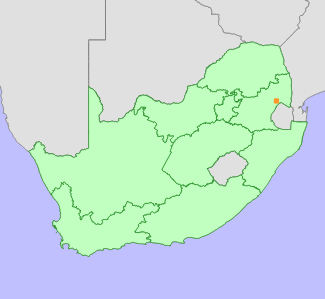|
Scientific Name | Protea curvata N.E.Br. |
Higher Classification | Dicotyledons |
Family | PROTEACEAE |
Common Names | Barberton Lowveld Sugarbush (e), Barberton Sugarbush (e), Barbertonse Laeveld-suikerbos (a), Serpentine Sugarbush (e), Serpentyn-suikerbos (a) |
National Status |
Status and Criteria | Vulnerable D2 |
Assessment Date | 2019/09/27 |
Assessor(s) | A.G. Rebelo, H. Mtshali & L. von Staden |
Justification | Protea curvata is a localized endemic, known from two locations in the Barberton area of South Africa. It is potentially threatened by habitat loss to mining and alien invasive plants. It is therefore listed as Vulnerable under criterion D. |
Distribution |
Endemism | South African endemic |
Provincial distribution | Mpumalanga |
Range | This species occurs only in the Barberton area in the Mpumalanga Province of South Africa. It has an extent of occurrence (EOO) and an area of occupancy (AOO) of 40 km². |
Habitat and Ecology |
Major system | Terrestrial |
Major habitats | Barberton Serpentine Sourveld |
Description | It grows in serpentine-derived soils, at 600-900 m and is a long-lived species, that survives fires by resprouting from aerial stems. Wind-dispersed seeds are not stored on the plant, and are released immediately after ripening. It is pollinated by birds. |
Threats |
| The population occurs adjacent to an abandoned mine. There has recently been renewed interest in mining in the Barberton area, and resuming of mining activities and associated infrastructure development is likely to rapidly cause this species to become Critically Endangered or possibly extinct. It is also potentially threatened by alien invasive plants. |
Population |
Protea curvata was thought to occur on a single hill prior to 1979 with 30-40 plants, adjacent hills were found to contain the species and the population was estimated in 1979 at 3000 plants (Onderstal 1979). Alternative figures of 1000 trees are reported (De Souza 1990). The Protea Atlas Project, conducted between 1992 and 2002, found the populations on two adjacent hills (separated by 1.5 km) over a 4 km long range. Estimates of population size from Protea Atlas data give a minimum and maximum size of 775-10000 plants. The population is locally common, stable and not threatened.
|
Population trend | Stable |
Conservation |
| It is not currently conserved in any formally protected area. |
Assessment History |
Taxon assessed |
Status and Criteria |
Citation/Red List version | | Protea curvata N.E.Br. | VU D2 | Raimondo et al. (2009) | | Protea curvata N.E.Br. | Vulnerable | Hilton-Taylor (1996) | | Protea curvata N.E.Br. | Uncertain | Hall et al. (1980) | |
Bibliography |
De Souza, B. 1990. Why must Transvaal Proteas take a back seat. Protea Atlas Newsletter 8:3.
Hall, A.V., De Winter, M., De Winter, B. and Van Oosterhout, S.A.M. 1980. Threatened plants of southern Africa. South African National Scienctific Programmes Report 45. CSIR, Pretoria.
Hilton-Taylor, C. 1996. Red data list of southern African plants. Strelitzia 4. South African National Botanical Institute, Pretoria.
Onderstal, J. 1979. Proteas of the eastern Transvaal. Veld & Flora 65:110-111.
Raimondo, D., von Staden, L., Foden, W., Victor, J.E., Helme, N.A., Turner, R.C., Kamundi, D.A. and Manyama, P.A. 2009. Red List of South African Plants. Strelitzia 25. South African National Biodiversity Institute, Pretoria.
Rebelo, T. 2001. Sasol Proteas: A field guide to the proteas of southern Africa. (2nd ed.). Fernwood Press, Vlaeberg, Cape Town.
|
Citation |
| Rebelo, A.G., Mtshali, H. & von Staden, L. 2019. Protea curvata N.E.Br. National Assessment: Red List of South African Plants version 2024.1. Accessed on 2025/12/23 |
 Comment on this assessment
Comment on this assessment

